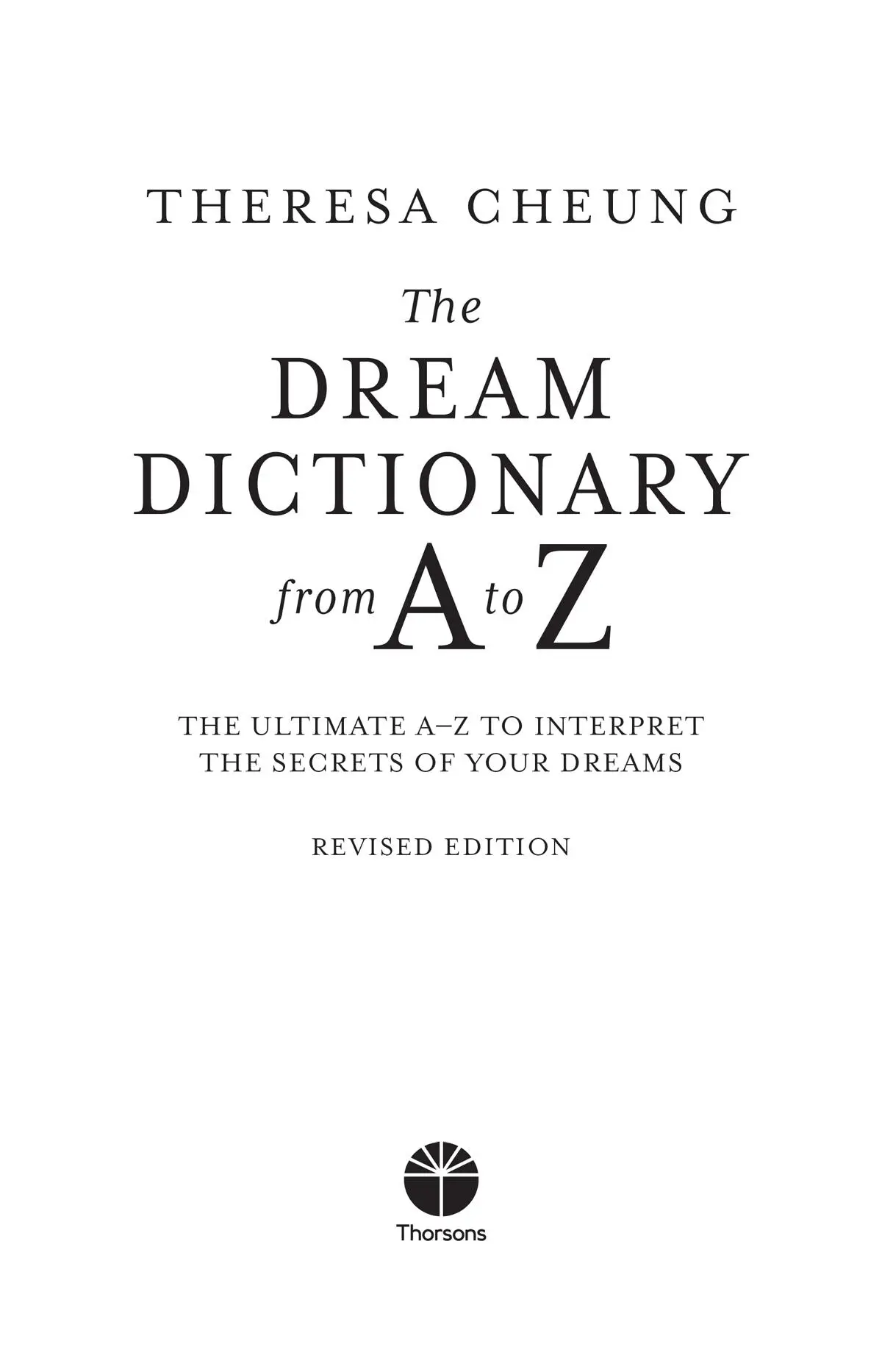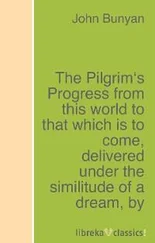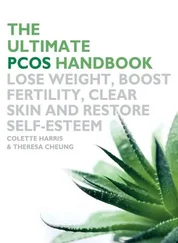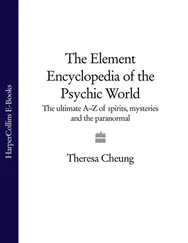
COPYRIGHT
Thorsons
An imprint of HarperCollins Publishers
1 London Bridge Street
London SE1 9GF
www.harpercollins.co.uk
Original edition first published as The Element Encyclopedia of 20,000 Dreams 2006
This revised and updated edition published by Thorsons 2019
© Theresa Cheung 2006, 2019
Cover design © HarperCollins Publishers Ltd 2019
Cover illustrations © Kathleen Edwards and Shutterstock.com (stars)
A catalogue record of this book is available from the British Library
Theresa Cheung asserts the moral right to be identified as the author of this work
All rights reserved under International and Pan-American Copyright Conventions. By payment of the required fees, you have been granted the nonexclusive, non-transferable right to access and read the text of this e-book on screen. No part of this text may be reproduced, transmitted, downloaded, decompiled, reverse engineered, or stored in or introduced into any information storage retrieval system, in any form or by any means, whether electronic or mechanical, now known or hereinafter invented, without the express written permission of HarperCollins e-books.
Find out about HarperCollins and the environment at www.harpercollins.co.uk/green
Source ISBN: 9780008366476
Ebook Edition © November 2019 ISBN: 9780007484096
Version 2019-09-24
C ONTENTS
Cover
Title Page
Copyright
Welcome to a Whole New World of Dreams
Introduction: Prepare to Dream
A–Z Bedside Reader
A
B
C
D
E
F
G
H
I
J
K
L
M
N
O
P
Q
R
S
T
U
V
W
X Y Z
The 50 Most Common Dreams
10 Common Dreams You Should Never Ignore
Acknowledgments
About the Publisher
W ELCOME TO A WHOLE NEW WORLD OF DREAMS
I dream, therefore I exist.
– J. August Strindberg
Dreams are timeless, but books written about them aren’t. That’s why I’m delighted this Dream Dictionary has earned itself a reissue. The images that appear in our dreams are informed by enduring archetypes and symbols, but also by what is current and relevant to our lives today. Being given the opportunity to update the Introduction and endmatter, and add some additional entries, close to fifteen years after this book was first written, ensures its relevance. I hope this updated version will remain a classic bedside dream companion for many years to come.
Night Visions
We’ve all woken up from dreams that have felt incredibly real, as if what we experienced actually happened, but then we wake up and can’t make any sense of whatever it was that we felt and saw. We wonder what it all meant.
The majority of dream researchers today believe that dreams are not random and meaningless but rich in messages from our unconscious. They are inner communications that, if we know how to interpret them, can be powerful tools for personal growth. Sadly, many of us forget our dreams when we wake up, and this is a great loss. According to the Talmud: ‘A dream which is not interpreted is like a letter which is not read.’
If you are to recall, understand, and work with your dreams, you first need to learn how to make sense of them. This Dream Dictionary is an illuminating guide to the most common symbols that are likely to appear in your dreamscape, a rich resource to help you unlock the wisdom of your night visions. Use it to find out what your dreams are trying to tell you. But before you submerge yourself in the intoxicating world of your dreams, take a moment to find out how you can make the very best use of this book.
How to Use This Book
This Dream Dictionary is arranged in three parts: the Introduction, the A to Z Bedside Reader, and a closing section dedicated to the Most Common Dreams, or dreams you are almost certain to have at some point in your life.
The Introduction has been updated to take account of the latest research into the hows, whys and whats of sleep. It explores the complexities of dream interpretation and what you need to know about unlocking the meaning of your dreams. Although the dominant theme is that dreams have a symbolic and psychological interpretation, there’s also information about precognitive dreaming here, and whether it is actually possible to see the future in your dreams. And if you struggle to remember your dreams, or simply want to have a more active dream life, you will gain a great deal from the advice offered in the dream recall section.
You are strongly advised to read the Introduction before using the A to Z Reader to look up relevant dream entries as the advice in the Introduction will inform and enrich what you discover in the Reader. Be sure to check out the Most Common Dreams section at the end of the book too – preferably before you start using the A to Z Reader. Knowing how to interpret these very common dreams will get you thinking along the right lines and help you interpret all your other dreams. There is also advice about the kinds of dreams you would be wise not to ignore.
The A to Z Bedside Reader is the main body of the book. It’s been lightly updated to include a few new symbols, such as SOCIAL MEDIA, which we are more likely to dream about today than when the Dream Dictionary was originally written. Dream messages can be difficult to decipher until you have learned their secret language, and this section will give you keys to the wealth of creativity and insight stored in your dreaming mind. Understanding what your dreams are trying to tell you can help you transform and grow as a person. Your dreams reveal your deepest emotional and spiritual needs and allow you to experiment with an endless range of emotions, situations, and scenarios in a completely safe way. Only dreams can offer you such excitement, education, and enlightenment.
The entries in the A to Z Reader are arranged alphabetically for ease of use, but be aware that some entries, like dog, for example, are placed in categories, in this instance PETS. You will also find cross-references in many entries to other entries that might be helpful. Common dream symbols are listed as well as classic dream themes, such as FLYING or FALLING, but there are, of course, limitations in the number of entries this book can offer you; dreams invite a world of infinite possibilities and there simply isn’t a book vast enough to contain them all. If you do want a larger resource, thousands more entries can be found in my earlier dream title, The Element Encylopedia of 20,000 Dreams . You are also welcome to contact me about your dreams and how best to interpret them.
How to Contact the Author
You can message me via my reader email – angeltalk710@aol.com– or via my Facebook and Instagram Theresa Cheung author pages. You can also contact me via my website: www.theresacheung.com. Please do subscribe to my email if you visit my website. It’s a way for me to share the latest dream research, reader stories, and interpretation advice.
Feel free to get in touch to discuss your dreams or if you have questions, unusual or supernormal stories, or insights you want to share with me and potentially with a wider audience. I endeavor to reply to everyone who reaches out to me. Please bear in mind that sometimes it can take a while for me to reply if things are super-busy, or if I need to take a little time out to do some dreaming of my own.
Читать дальше
![Theresa Cheung The Dream Dictionary from A to Z [Revised edition] обложка книги](/books/618735/theresa-cheung-the-dream-dictionary-from-a-to-z-r-cover.webp)






![Theresa Cheung - The Dream Dictionary from A to Z [Revised edition] - The Ultimate A–Z to Interpret the Secrets of Your Dreams](/books/692092/theresa-cheung-the-dream-dictionary-from-a-to-z-r-thumb.webp)





